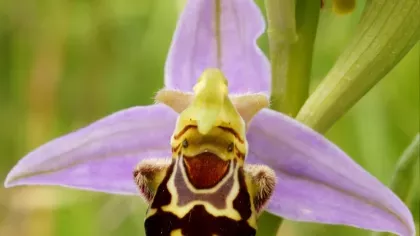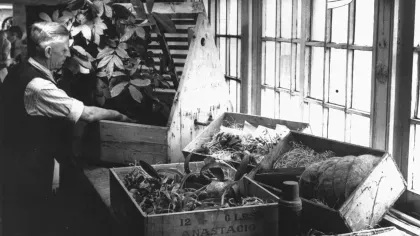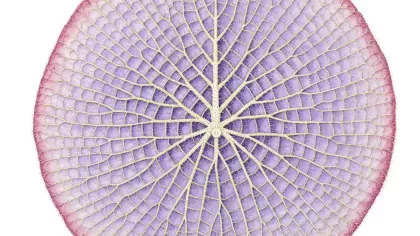13 November 2023
Highlights of Mat Collishaw: Petrichor
Algorithms, Victorian inventions and bringing 'tulip mania' to the 21st century.

Oil paintings meet algorithms as Mat Collishaw explores the relationship between art, technology and nature in Petrichor – now open at the Shirley Sherwood Gallery of Botanical Art.
A critically acclaimed contemporary British artist who uses video, photography and the power of illusion, Collishaw brings three pioneering new pieces to Kew alongside his critically acclaimed existing works.
Petrichor runs from 20 October 2023 to 7 April 2024. We asked Collishaw for his perspective on this thought-provoking exhibition.

Alluvion (UK premiere)
This series of oil paintings is inspired by the work of 17th century artists such as Frederik Ruysch and Abraham Mignon.
Collishaw used an algorithm to combine the Old Masters’ still-life paintings with insect body parts, and then painted from the resulting ‘freakish’ AI-generated images. Look closer and you’ll notice that the painted flowers are subtly insect-like.
He was inspired by Pouyannian mimicry: the natural phenomenon in which flowers like the bee orchid evolve to trick male pollinating insects by looking or smelling like a female insect.

‘I’ve come to see flowers as little primal breeding machines,' says Collishaw.
'This form of natural mimicry is not a conscious process but a result of natural selection. It happens blindly, but over generations, the flower's appearance becomes ever more effective. And there's a very real similarity between what's happening with artificial intelligence and what happens with genetics.'
The title of each painting is also AI-generated – Alluvion is a Latin word describing a landscape covered in detritus after a flood.
‘We are now being saturated by digital media, and it's changing the landscape we live in. We are creating new worlds and we are often blind to what we will emerge with.’

The Venal Muse
Displayed alongside Alluvion is The Venal Muse (2012), a series of flower sculptures with fleshy, animalistic textures and shapes, inspired by the decadence and lost innocence of Charles Baudelaire’s Les Fleurs du Mal.

Even to the End (UK premiere)
This nine minute panoramic video projection is inspired by the Wardian case. The Victorians used these early terrariums to transport plants across oceans and continents for the first time. Here, it represents the contrast between humanity’s capacities to both protect and destroy nature.
Collishaw worked with a Ukrainian video artist to create this poignant, digitally-rendered sequence where plants float through the sea to find a lush island that begins to slowly decay.

The soundtrack is Samuel Barber’s Adagio for Strings, in turn inspired by Virgil’s poem The Georgics.
‘This poem talks about how we manage the land: how we look after it, but also the potential for devastation like forest fires and floods. It was written a couple of thousand years ago and it’s still a poem that is relevant today.
If my artwork can make reference to what's happening to the environment, hopefully it becomes part of the discussion that people are having. Art can function as a forum for these debates to take place.'
Inspired by the current climate crisis, the exhibition title Petrichor means 'the smell of rain on parched soil'.

Heterosis (global premiere)
Inspired by the ‘tulip mania’ of the 17th century, this piece receives its global gallery premiere at Kew.
In 1630s Holland, collectors wanted the rarest and most beautiful tulip and prices skyrocketed – until history’s first recorded speculative bubble finally burst in 1637.
Collishaw saw echoes of tulip mania in the recent rise and fall of the NFT market, leading him to create the Heterosis project: a series of digital collectible flowers, each of which can be bought and bred with other participants’ flowers to create custom hybrids.
Generated by an algorithm, each flower has a ‘genetic code’ complete with hidden recessive ‘genes’ that will only show up in certain hybrids.
Participants can view the entire Heterosis collection in a digital recreation of Room 32 of the National Gallery, rendered as if it were abandoned and overgrown.

‘At the time of tulip mania, there was this big debate about whether tulips were more beautiful than oil paintings. Which is more beautiful, nature or artifice? As we are now swamped with digital media, I wanted to create a contrast between digital artworks and the oil on canvas paintings inside the National Gallery: which is more beautiful?’
In Kew's Shirley Sherwood Gallery, watch as each unearthly flower opens and closes in turn, revealing transparent petals, metallic stripes and colours that most gardeners can only dream of.

Albion
This arresting piece fills the main gallery with a huge, spectral oak tree. Collishaw captured the 800-year-old major oak in Sherwood Forest using a laser scanner to create a ‘Pepper’s ghost’ illusion: the tree looks three-dimensional as it slowly spins.
Created in 2016 to 2017 during the EU referendum, the title Albion refers to the ancient oak tree as an emblem of England – a ghostly apparition supported by chains and crutches.

Whispering Weeds and Columbine
In Gallery 1, Columbine (2018) and Whispering Weeds (2011) are animated versions of 500-year-old watercolours by the German Renaissance artist Albrecht Dürer (1471 to 1528).
These masterpieces, Columbine and The Great Piece of Turf, are widely regarded as some of the first examples of botanical art as we know it today.
Here, each painted stalk wafts gently in an unseen breeze, making old artwork pioneering once more.

The Centrifugal Soul
Created in 2016, this modern zoetrope uses a similar technique to Collishaw’s 2014 work, All Things Fall.
A strobe light creates ‘frames’ as the central zoetrope spins to animate its 3D-printed bowerbirds and birds of paradise. They show off their mating dances against a backdrop of ornate flowers, perpetually in bloom.

Like Heterosis, The Centrifugal Soul reflects on humanity’s seemingly never-ending search for aesthetic appeal.
It embodies the idea that technology feeds our evolutionary urge to be noticed, encouraging us to perform an idealised version of ourselves in a constant battle for attention.
‘This exhibition is like a seed and the ideas that I've infused are little roots, reaching out and trying to find nutrients. There are lots of different disciplines and ideas in these quite simply presented works and I hope people give them a bit of time to tease that out,’ says Collishaw.


